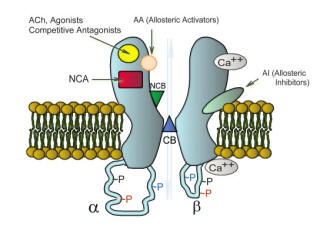Significance
The significance of our studies lies in several areas pertinent to the different functions of nAChRs.
(1) The concept of cholesterol-sensitive AChRs.
One example of the importance of the proposed studies is the characterization of the novel lipid-exposed αC418W mutation in Torpedo californica and muscle-type AChRs (Lee, et. al., 1994, Lasalde, et. al., 1996, Ortiz-Miranda, et. al, 1997; Tamamizu, et. al., 1999; Santiago, et. al., 2001; Baez-Pagan, et. al., 2008) which predicted that this lipid-exposed mutant was a slow-channel mutation. Recently, a Slow-Channel Congenital Myasthenic Syndrome (SC-CMS) was shown to be caused by the same αC418W mutation in humans (Shen X-M, et. al., 2006). We had developed a transgenic mice model for the αC418W in collaboration with Dr. Christopher Gomez (U. Chicago) two years before this SC-CMS was reported, and now a fundamental aspect of the proposed research is to define the mechanism by which this novel lipid-exposed mutant leads to endplate myopathy in humans.
(2) In vivo , lipid-protein interactions.
We developed a database of over 400 lipid-exposed mutations located in the M3 and M4 (lipid-domains) of the Torpedo californica and muscle-type nAChRs (Cruz-Martin, et. al., 2001; Guzman, et. al., 2003; Santiago, et. al., 2004: Ortiz-Acevedo, et. al., 2004; Guzman, et. al., 2006; Otero-Cruz, 2007; Otero-Cruz et al., 2008; Lizardi-Ortiz et al., 2008; Diaz-, et al., 2008, Channels; Otero-Cruz et al., 2010). The functional characterization of these database led to the discovery of several mutations that introduce caveolin binding motifs and also display a cholesterol sensitivity similar to or higher than that of the αC418W mutation. These cholesterol-sensitive mutations will be delivered into the mouse endplate (and isolated muscle fibers) using in vivo gene transfer of GFP-tagged AChRs. These approaches will further develop the concept of cholesterol-sensitive acetylcholine receptor in vivo using a mammalian expression system.
(3) Understanding the molecular basis for collateral effects of statins.
Muscle problems are the most commonly reported adverse effects of statins. The safety of statins in long-term use is an incredibly important question for which there are very few data available. Our studies will serve both to identify novel pathways for postsynaptic neurodegeneration during statins treatment and also to identify practical strategies for therapeutic intervention with long-term benefit to cholesterolemic patients. Most important, our results have raised the possibility that collateral effects of statins could uncover genetic defects in humans.
(4) Slow Channel Congenital Myasthenic Syndrome (SC-CMS).
These studies will serve both to advance treatment of SC-CMS and to assess the relative contribution of different environmental factors such as alcohol, nicotine, and statins to the enhancement of neuromuscular weakness and synaptic degeneration in vivo .
(5) Upregulation of α7 nicotinic receptors in HIV.
Recently we showed that HIV-1 envelope neurotoxin, gp120 induces a functional upregulation of the α7 nicotinic acetylcholine receptor (AChR) in human macrophages and neuronal cell lines in vitro . We confirmed the upregulation of α7 AChR in monocytes, macrophages and lymphocytes from HIV infected patients. Our goal is to define the functional link between the upregulation of the α7 AChR and HIV/AIDS disease progression.

